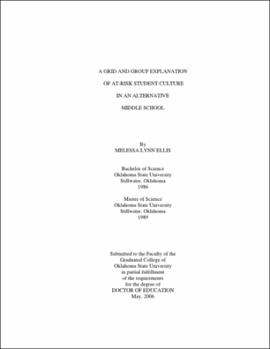| dc.contributor.advisor | Harris, Ed | |
| dc.contributor.author | Ellis, Melessa Lynn | |
| dc.date.accessioned | 2013-11-26T08:34:24Z | |
| dc.date.available | 2013-11-26T08:34:24Z | |
| dc.date.issued | 2006-05 | |
| dc.identifier.uri | https://hdl.handle.net/11244/7383 | |
| dc.description.abstract | Scope and Method of Study: Using the lens of Mary Douglas's (1982) Grid and Group Typology, the purpose of this study was: (1) to describe the culture of an alternative school environment at the middle school level; (2) investigate the roles of at-risk students in the culture of an alternative school by describing how they interact among themselves and with the teacher; and (3) to describe the perceptions of at-risk students regarding their educational needs and goals in relation to the values and dimensions of an alternative school culture. The participants in this mini-ethnography included at-risk middle level alternative school students enrolled in the Transitional Learning Center (TLC) at a middle school in the mid-west, referred to in the study as Boyle Middle School. Multiple methods, including interviews, observations, and document analysis, were used for data collection. | |
| dc.description.abstract | Findings and Conclusions: Through this study, the Transitional Learning Center was best described as an Individualist (low-grid/low-group) culture, meaning that rules and traditions are not embedded or imposed, and that the success of the individual is more important than the success of the group. Even though students worked well together when necessary, and a few friendships existed, no group bond was evident in this class. Students strongly expressed their beliefs regarding their learning styles, characteristics of good teachers, and even the type of facility that would create the best environment for them. Students also identified barriers, such as school size, teacher attitude, and homework, that attributed to their lack of success. The teacher had much to do with the program's success in that he set high expectations, gained student trust and respect, and individualized the curriculum as much as possible. He also held students accountable for their own decisions while motivating them to do their best in all aspects of life. | |
| dc.format | application/pdf | |
| dc.language | en_US | |
| dc.rights | Copyright is held by the author who has granted the Oklahoma State University Library the non-exclusive right to share this material in its institutional repository. Contact Digital Library Services at lib-dls@okstate.edu or 405-744-9161 for the permission policy on the use, reproduction or distribution of this material. | |
| dc.title | Grid and group explanation of at-risk student culture in an alternative middle school | |
| dc.contributor.committeeMember | Pettibone, Tim | |
| dc.contributor.committeeMember | Stern, Ken | |
| dc.contributor.committeeMember | Stansberry, Susan | |
| osu.filename | Ellis_okstate_0664D_1704.pdf | |
| osu.accesstype | Open Access | |
| dc.type.genre | Dissertation | |
| dc.type.material | Text | |
| thesis.degree.discipline | Educational Leadership | |
| thesis.degree.grantor | Oklahoma State University | |
